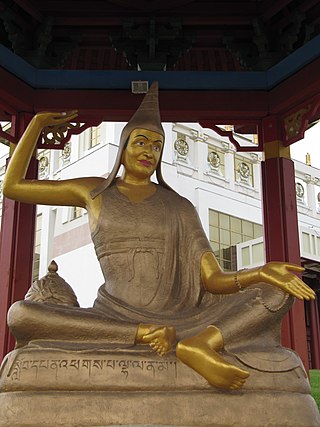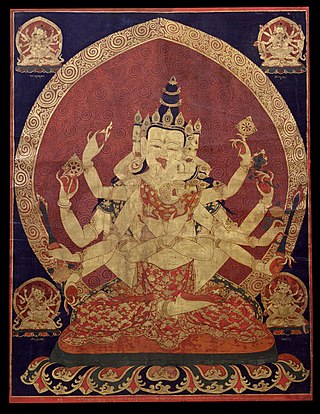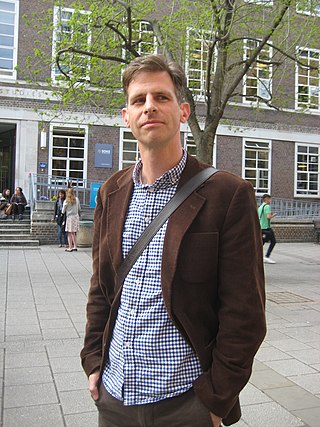
Vajrayāna, also known as Mantrayāna, Guhyamantrayāna, Tantrayāna, Secret Mantra, Tantric Buddhism, and Esoteric Buddhism, is a Buddhist tradition of tantric practice which developed in the medieval Indian subcontinent and spread to Tibet, Nepal, other Himalayan states, East Asia, and Mongolia.
Reginald Ray is an American Buddhist academic and teacher.

Robert Alexander Farrar Thurman is an American Buddhist author and academic who has written, edited, and translated several books on Tibetan Buddhism. He was the Je Tsongkhapa Professor of Indo-Tibetan Buddhist Studies at Columbia University, before retiring in June 2019. He was the first endowed chair in Buddhist Studies in the West. He also is the co-founder and president of the Tibet House US New York. He translated the Vimalakirti Sutra from the Tibetan Kanjur into English. He is the father of actress Uma Thurman.

The schools of Buddhism are the various institutional and doctrinal divisions of Buddhism that have existed from ancient times up to the present. The classification and nature of various doctrinal, philosophical or cultural facets of the schools of Buddhism is vague and has been interpreted in many different ways, often due to the sheer number of different sects, subsects, movements, etc. that have made up or currently make up the whole of Buddhist traditions. The sectarian and conceptual divisions of Buddhist thought are part of the modern framework of Buddhist studies, as well as comparative religion in Asia.

The term American Buddhism can be used to describe all Buddhist groups within the United States, including Asian-American Buddhists born into the faith, who comprise the largest percentage of Buddhists in the country.
Paul J. Griffiths is an English-born American theologian. He was the Warren Professor of Catholic Thought at Duke Divinity School.

Theosophical teachings have borrowed some concepts and terms from Buddhism. Some theosophists like Helena Blavatsky, Helena Roerich and Henry Steel Olcott also became Buddhists. Henry Steel Olcott helped shape the design of the Buddhist flag. Tibetan Buddhism was popularised in the West at first mainly by Theosophists including Evans-Wentz and Alexandra David-Neel.
The University of Chicago Divinity School is a private graduate institution at the University of Chicago dedicated to the training of academics and clergy across religious boundaries. Formed under Baptist auspices, the school today lacks any sectarian affiliations.

Āryadeva, was a Mahayana Buddhist monk, a disciple of Nagarjuna and a Madhyamaka philosopher. Most sources agree that he was from "Siṃhala", which some scholars identify with Sri Lanka. After Nagarjuna, he is considered to be the next most important figure of the Indian Madhyamaka school.
Judith Simmer-Brown is a Distinguished Professor of Contemplative and Religious Studies Emerita at Naropa University. She has expertise in Tibetan Buddhism, Women and Buddhism, Buddhist-Christian dialogue, Western Buddhism and Contemplative Education. She is an acharya — a senior Buddhist teacher — in the Shambhala Buddhist tradition and was a senior student of Chögyam Trungpa Rinpoche. She serves on the board of the Society of Buddhist-Christian Studies, and is on the steering committee of the Contemplative Studies Group of the American Academy of Religion. Previously she was a member of the Lilly Buddhist-Christian Theological Encounter.
Donald Sewell Lopez Jr. is the Arthur E. Link Distinguished university professor of Buddhist and Tibetan Studies at the University of Michigan, in the Department of Asian Languages and Cultures.
Lamdré is a meditative system in Tibetan Buddhism rooted in the view that the result of its practice is contained within the path. The name "lamdré" means the “path" with its fruit Wylie: ‘bras). In Tibet, the lamdré teachings are considered the summum bonum of the Sakya school.
Daniel A. Arnold is an American scholar and philosopher. He is Associate Professor of the Philosophy of Religions at the Divinity School of the University of Chicago.
Buddhist studies, also known as Buddhology, is the academic study of Buddhism. The term Buddhology was coined in the early 20th century by the Unitarian minister Joseph Estlin Carpenter to mean the "study of Buddhahood, the nature of the Buddha, and doctrines of a Buddha", but the terms Buddhology and Buddhist studies are generally synonymous in the contemporary context. According to William M. Johnston, in some specific contexts, Buddhology may be viewed as a subset of Buddhist studies, with a focus on Buddhist hermeneutics, exegesis, ontology and Buddha's attributes. Scholars of Buddhist studies focus on the history, culture, archaeology, arts, philology, anthropology, sociology, theology, philosophy, practices, interreligious comparative studies and other subjects related to Buddhism.
Matthew T. Kapstein is a scholar of Tibetan religions, Buddhism, and the cultural effects of the Chinese occupation of Tibet. He is Numata Visiting Professor of Buddhist Studies at the University of Chicago Divinity School, and Director of Tibetan Studies at the École pratique des hautes études.

The Guhyasamāja Tantra, also known as the Tathāgataguhyaka, is one of the most important scriptures of Tantric Buddhism, written in Sanskrit. In its fullest form, it consists of seventeen chapters, though a separate "explanatory tantra" (vyākhyātantra) known as the Later Tantra is sometimes considered to be its eighteenth chapter. Many scholars believe that the original core of the work consisted of the first twelve chapters, with chapters thirteen to seventeen being added later as explanatory material.

Sam Julius van Schaik is an English tibetologist.

Chinese Esoteric Buddhism refers to traditions of Tantra and Esoteric Buddhism that have flourished among the Chinese people. The Tantric masters Śubhakarasiṃha, Vajrabodhi and Amoghavajra, established the Esoteric Buddhist Zhenyan tradition from 716 to 720 during the reign of Emperor Xuanzong of Tang. It employed mandalas, mantras, mudras, abhiṣekas, and deity yoga. The Zhenyan tradition was transported to Japan as Shingon Buddhism by Kūkai as well as influencing Korean Buddhism. The Song dynasty (960–1279) saw a second diffusion of Esoteric texts. Esoteric Buddhist practices continued to have an influence into the late imperial period and Tibetan Buddhism was also influential during the Yuan dynasty period and beyond. In the Ming dynasty (1368–1644) through to the modern period, esoteric practices and teachings became absorbed and merged with the other Chinese Buddhist traditions to a large extent.
Bryan J. Cuevas is an American Tibetologist and historian of religion. He is John F. Priest Professor of Religion and Director of Buddhist and Tibetan Studies at Florida State University, where he specializes in Tibetan Buddhist history, literature, and culture. His research focuses on Tibetan history and historiography, hagiography and biographical literature, Buddhist popular religion, the literary history of death narratives and death-related practices, and the politics of magic and ritual power in premodern Tibetan societies, from roughly the eleventh through the early eighteenth centuries.
Janet Gyatso is a Religious Studies scholar currently employed as the Hershey Professor of Buddhist Studies and the Associate Dean for Faculty and Academic Affairs at Harvard Divinity School. She is a member of the American Academy of Arts and Sciences. Gyatso's research interests are in Buddhism and its relationship to Tibetan and South Asian civilizations.








